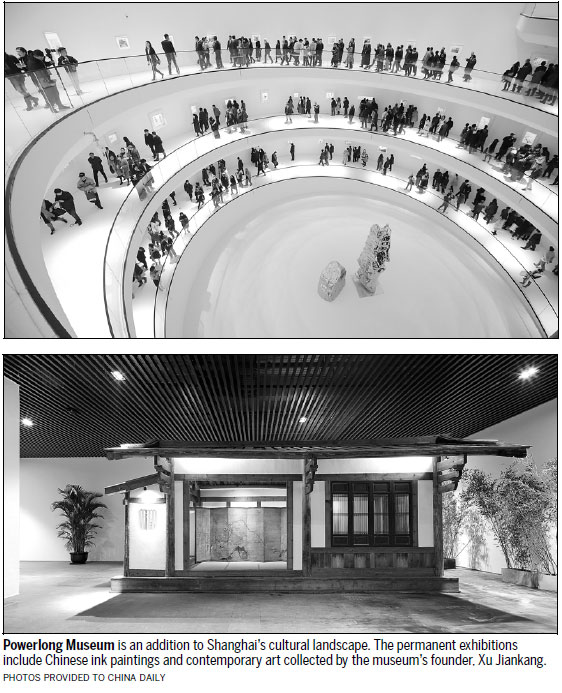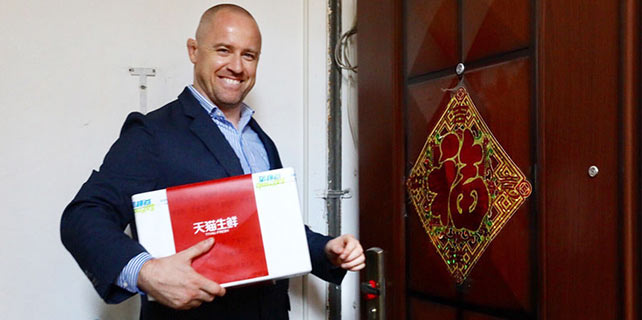Real estate to canvas
A new museum highlights the trend of private companies investing in art in China. Lin Qi reports.
Powerlong Museum, among the latest additions to Shanghai's private art destinations, stands alone in the metropolis' far southwestern Minhang district. Many other such institutions, such as the Long Museum, Yuz Museum and Shanghai Center of Photography, are found in the well-known West Bund area, closer to the city center.
The real estate company Powerlong Group has opened Powerlong Museum near its headquarters, a shopping mall, a hotel and other offices.
Because of its proximity to Hongqiao Airport, the roar of airplanes overhead can also be heard.
The museum's grand opening on Nov 18 was attended by socialites from across the country and prominent figures from the art world, including Liu Yiqian, the billionaire collector who founded the Long Museum, Qiao Zhibing, a noted art collector and gallery owner, and Zhao Xu, executive director of the Beijing Poly International Auction, one of China's leading auctioneers.
Powerlong Museum has been built on the art collection of Xu Jiankang, the 65-year-old founder of the Powerlong Group who has feverishly been collecting art for the past decade.
Xu describes the museum as an initiative to "give a boost to China's cultural course and people's sense of happiness as a result of the country's rising economic power".
The three permanent exhibitions unveiled along with the opening, shows Xu's collection ranging from modern Chinese ink-brush paintings to contemporary art.
Featured artists include Cai Guoqiang, a New York-based artist whose fireworks performance project Sky Ladder held in 2015 in China was sponsored by Xu. The two hail from Quanzhou, East China's Fujian province.
Zhan Wang's stainless steel sculptures from his best-known Artificial Rocks series are also on show.
He has modeled the works after jiashanshi (artificial rocks), a common decoration in classical Chinese gardens, and seeks a communication between cultural traditions and contemporary technologies.
There are also works of up-and-coming artists like Dong Lin who is a postgraduate student at Beijing's Central Academy of Fine Arts. She spends a lot of time working in Jingdezhen, Jiangxi province, which is known as the porcelain capital of China. Her three porcelain installations on display are inspired by Shanhaijing, a classic compilation of texts on myths.
What is at the heart of Xu's collection and the museum's showcase is a dozen of paintings created by ink-brush masters of 20th-century China. They cost a great sum of money when Xu made successful bids on them at auction. They are now on display together to the public for the first time since Xu bought them.
Highlights include Zhichi Tianya, an album of 12 landscapes by Qi Baishi, which fetched 195.5 million yuan ($29.6 million) last year, Zhang Daqian's painting, titled A Copy of Ju Ran's Landscape, which sold for 103.5 million yuan, and Huang Zhou's Joyful Grassland, on which Xu spent 128.8 million yuan in 2013.
Li Xiaofeng, director of the Powerlong Museum, says one of their missions has been to show how Chinese ink-brush art evolved throughout the 20th century. Future exhibitions will focus on the masters and the different painting schools they heralded.
"The Chinese cultural identity is important as China integrates with the world. That will be the topic we will continue to center our exhibitions around, and invite audiences to anticipate the development of Chinese culture over the next 100 years," Li says.
The museum occupies a space of 23,000 square meters and has 10 exhibition halls. Except from the permanent displays, there is still a lot of space left to play with.
"Too spacious" is what many of the museum's first visitors seemed to say after its opening ceremony.
Li says the empty exhibition halls will be saved for curated exhibitions on the academic front and solo shows of noted artists, and there are also spaces for renting out.
Entrepreneurs and private companies have over the recent years dominated spaces for art collections in China. They won dozens of bidding wars in which artworks were sold for more than 10 million yuan, and which set auction records for artists or a category of antiquities.
This fueled a boom in private museums - motivated by a desire to show their cultural assets and their wealth.
A report on global private art museums in 2015 says Shanghai ranked after Beijing and Guangzhou in the number of private museums, and the three cities were home to more than 70 percent of China's private museums.
The report was jointly compiled by Larry's List, an art market monitor company based in Hong Kong, and Art Market Monitor of Artron in Beijing.
Xu is not the only private collector to enrich Shanghai's art landscape.
Hotelier Zheng Hao opened his own gallery in September. On Saturday, Suning Group, one of the country's largest retailers, unveiled its museum and many of the artworks on display were bought at auctions both at home and abroad.
Contact the writer at linqi@chinadaily.com.cn


(China Daily 11/28/2017 page20)
















